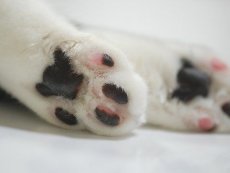Top Ten Recommendations for Caring for Cat Paws
Last reviewed: 19.10.2021

All iLive content is medically reviewed or fact checked to ensure as much factual accuracy as possible.
We have strict sourcing guidelines and only link to reputable media sites, academic research institutions and, whenever possible, medically peer reviewed studies. Note that the numbers in parentheses ([1], [2], etc.) are clickable links to these studies.
If you feel that any of our content is inaccurate, out-of-date, or otherwise questionable, please select it and press Ctrl + Enter.

Cats need healthy paws to scratch, clamber, and also for their famous acrobatic landings. Therefore it is important to regularly inspect and clean the cat's paws, and also to monitor whether there are any wounds.
Let's start from the beginning - the cat's paws should always be clean. Dirt, toilet filler or household chemicals should not contaminate its paws. In addition to the fact that they can cause pain, the harmful substances that are on the paws can end up on the tongue during washing. Daily, once a day, gently wipe the paws with a damp cloth. Be sure to wipe between the toes and around the paws. On the floor and other surfaces there should be no debris and household chemicals, it will help to keep the cat's paws clean (and also your furniture).
- Curiosity
Cats are explorers by nature, who sometimes find themselves in unfamiliar places. This is in the order of things for the inhabitants of the house, and for street cats. Therefore, regularly check the paws of your little wanderer for cuts, ulcers, splinters or swelling, which may require treatment.
- Scraping
Cats need to be scraped to dump the outer shell of the claws and make the claws sharp and smooth. The cat should have several different scrapes so that they do not bother her, and she does not scratch the furniture. In order for the cat to examine the scrapes, strangle them with catnip.
- Claws
Prepare the cat for clipping of claws, massaging its paws so that it is used to the fact that they are touched. We recommend cutting only 1 to 2 claws per session. When the cat is calm and relaxed, follow these steps:
- Gently press the upper part of the foot and the pads of the fingers from below - this is to force it to release the claws.
- Cut the white tip of each claw to the point where it bends, using sharp high-quality scissors to cut off claws in cats.
- Be careful not to touch the blood vessel inside the claw. This pink patch is visible through the claw.
- If you still accidentally clip the pink patch, it can bleed, in which case we can use a hemostatic powder.
- Be sure to praise the cat and give her a favorite treat every time you touch her paws and cut off the claws.
- Fluffy legs
In long-haired cats, the hair can grow between the fingers. If this irritates the cat (you'll know this if it excessively licks this coat), trim these cute bunches of wool with small rounded scissors.
- Healthy feet
Regularly inspect the cat's paws to make sure that there are no wounds and infection. Carefully remove splinters or splinters with tweezers and rinse any cuts. If you notice blood, pus or an unusual smell, take the cat to the vet so that he checks to see if there are any infections.
- Protect your paw pads
Be careful with the sensitive pads of the cat's paws. In hot and cold weather, moisten them with a remedy that the vet will recommend, and try not to touch the cold terraces, hot sidewalks and other uncomfortable surfaces.
- Language of the body
If you notice that the cat is obsessively washing the paws, limping or not stepping on the foot, inspect it. Maybe the veterinarian needs help.
- It's in the genes
Most cats do not suffer from paw disease, but a small investigation to find out what diseases your cat's breed is susceptible to can help a lot to maintain the health of its paws.
- Amputation of claws
Claw amputation is a surgical operation that involves amputation of the fingertips of a cat and causes considerable pain during the recovery period. Concern with the understanding of the need to scratch the cat, providing it with nails, regularly cutting off its claws and exploring other ways to combat destructive scratching.
